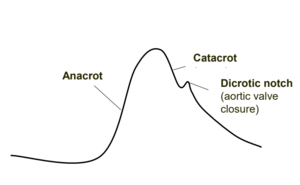34. The arterial and the venous pulse. Basic principles of hemodynamics.
When we talk about the pulse, we refer to the arterial pulse. The arterial pulse is the periodic, tactile vibration which can be felt at different points on the body. The pulse is the result of the heart pumping. When the heart pumps, a pressure wave propagates along the arterial blood vessels, and when this pressure wave reaches a pulse point a pulse can be felt.
The pulse rate is the same as the heart rate in normal cases.
The arterial pulse wave which propagates along the arterial blood vessels becomes smaller and smaller as it travels along the arteries. For this reason, there is no pulsatile flow, only continuous flow, at the level of the capillaries and veins.
Palpation points of the pulse
The pulse can be felt at many points on the body. It can only be felt on arteries which are near to the surface of the body, and which lie above bony surfaces.
Most important palpation points:
- Radial artery
- Carotid artery
- Axillary artery
- Cubital artery
- Ulnar artery
- Femoral artery
- Popliteal artery
- Dorsalis pedis artery
- Temporal artery
When palpating a pulse, two or three fingers should be used.
Characteristics of the pulse
The pulse has many characteristics. It can be regular, irregular, hard, soft, etc. Below is a table of the important different characteristics of the pulse:
| Quality | Characteristic | |
| Rhythm | Regular | Irregular (arrhythmic) |
| Rate | Frequens (tachycardic) | Rarus (bradycardic) |
| Hardness | Durus (hard) | Mollis (soft) |
| Amplitude/size/strength | Altus (large amplitude) | Parvus (small amplitude) |
| Equality | Equalis | Inequalis |
| Pulse wave increase | Celer (fast) | Tardus (slow) |
ARTERIAL PULSE CURVE

The way the arterial pulse varies with time can be drawn as a curve.
The ascending part of the pulse curve is called the anacrot and the descending part is called the catacrot. On the catacrot there is the dicrotic notch, also called the incisura, which occurs when the aortic valve closes.
The amplitude of the arterial pulse curve is not affected by changes in the frequency.
